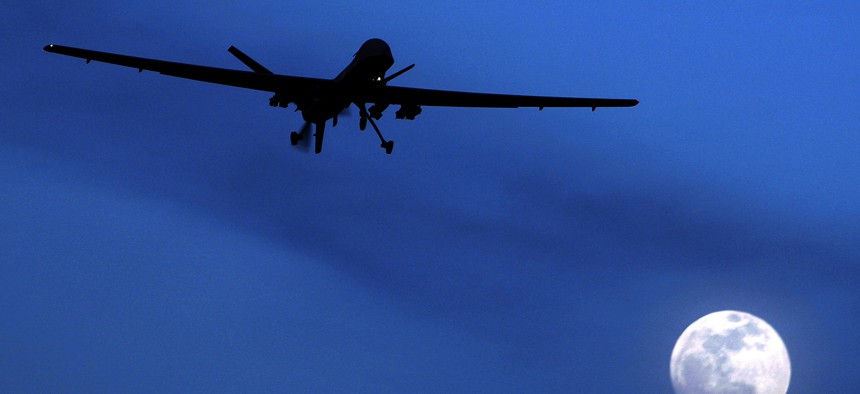
In this Jan. 31, 2010, file photo, an unmanned U.S. Predator drone flies over Kandahar Air Field, southern Afghanistan, on a moon-lit night. AP Photo
How Many Civilians Die in Covert US Drone Strikes? It Just Got Harder to Say
Trump has revoked an Obama-era reporting requirement even as the CIA has resumed lethal strikes.
The U.S. intelligence community is no longer required to reveal how many civilians die in U.S. drone strikes and counterterrorism operations outside war zones, even as the CIA broadens its lethal-drone program.
Overturning an Obama-era rule by executive order, President Trump declared that the director of national intelligence need no longer issue “an unclassified summary of the number of strikes undertaken by the United States government against terrorist targets outside areas of active hostilities, as well as assessments of combatant and non-combatant deaths resulting from those strikes, among other information.”
The White House chose last year not to release the report and was facing a May 1 deadline for this year’s accounting. Officials on Wednesday suggested that the reporting requirement was redundant because Congress last year ordered the Defense Department to annually submit a broader report on civilian casualties caused by U.S. military air and land operations worldwide.
But the legislation also allows the defense secretary to classify the information if he certifies that its public release would “pose a threat to the national security interests of the United States.” And perhaps more significantly, critics of the move point out, the Obama-era rule also covered CIA strikes — not just Defense Department strikes.
“The ‘context’ that the administration is providing is disingenuous,” Ned Price, a National Security Council spokesman under Obama, said on Twitter. “The Obama-era requirement applied to operations outside areas of active hostilities. The NDAA reporting requirement the administration is pointing to applies only to DOD operations in active war zones.”
A National Security Council spokesperson said in a statement that Trump’s action “eliminates superfluous reporting requirements, requirements that do not improve government transparency, but rather distract our intelligence professionals from their primary mission.”
The Trump administration has breathed new life into the CIA’s covert drone program, which Obama sought to suffocate by shifting control of drone attacks to the military in the final years of his presidency. Over the past two years, the spy agency has resumed conducting strikes, rather than passing intelligence to the Pentagon to carry out attacks. The New York Times reported in September that the agency now operates a drone base in northeastern Niger, within range of both southwestern Libya and the Sahel region of Africa. (The Wall Street Journal has also reported that the agency has conducted lethal strikes in Syria, which is considered an area of active hostilities and therefore would not have been released under the old rules.)
The Pentagon has also increased its lethal drone strikes in some areas. In Somalia, they are on pace to triple last year’s tally. But as of last year, the Trump administration had designated much of Somalia an area of active hostilities, according to the Times, meaning that it too would not have been accounted for under the old rules.
Much of the criticism of the drone program — and in particular, the CIA’s authority to conduct lethal strikes — has centered on civilian casualties. Human rights advocates believe that the clandestine agency is less publicly accountable to policymakers and the public and therefore has the potential to be more profligate in its use of force.
The Journal has reported that when strike authority was returned to the agency, it was required to meet a standard of “near certainty” that civilians would not be harmed when assessing targets, as opposed to the lower “reasonable certainty” standard that the Defense Department must meet in active war zones. But where the Defense Department publicizes its counterterror strikes, the agency does not — and congressional oversight of the CIA takes place behind closed doors by the Senate and House Intelligence Committees.
“This requirement was about more than transparency,” Price tweeted. “It allowed, for the first time, the US to counter disinformation from terrorist groups with facts about the effectiveness and precision of our operations. It was an important tool that we're again without.”
Still, the two Obama-era reports provided little in the way of detail, offering only the total strike number, and combatant and non-combatant deaths. In 2016, the intelligence community reported only one civilian casualty.
Trump himself has drawn fire for remarks that critics say show a disturbing callousness for civilian life. On the campaign trail, he vowed to fight terrorists by “tak[ing] out their families.”
On the new president’s first visit to the CIA, the agency’s head of drone operations told Trump that it had developed special munitions to limit civilian casualties, the Washington Post reported. Trump was shown a video feed from a strike in which the agency did not fire until the target had walked away from a house with his family inside.
“Why did you wait?” Trump asked, according to one participant in the meeting.




